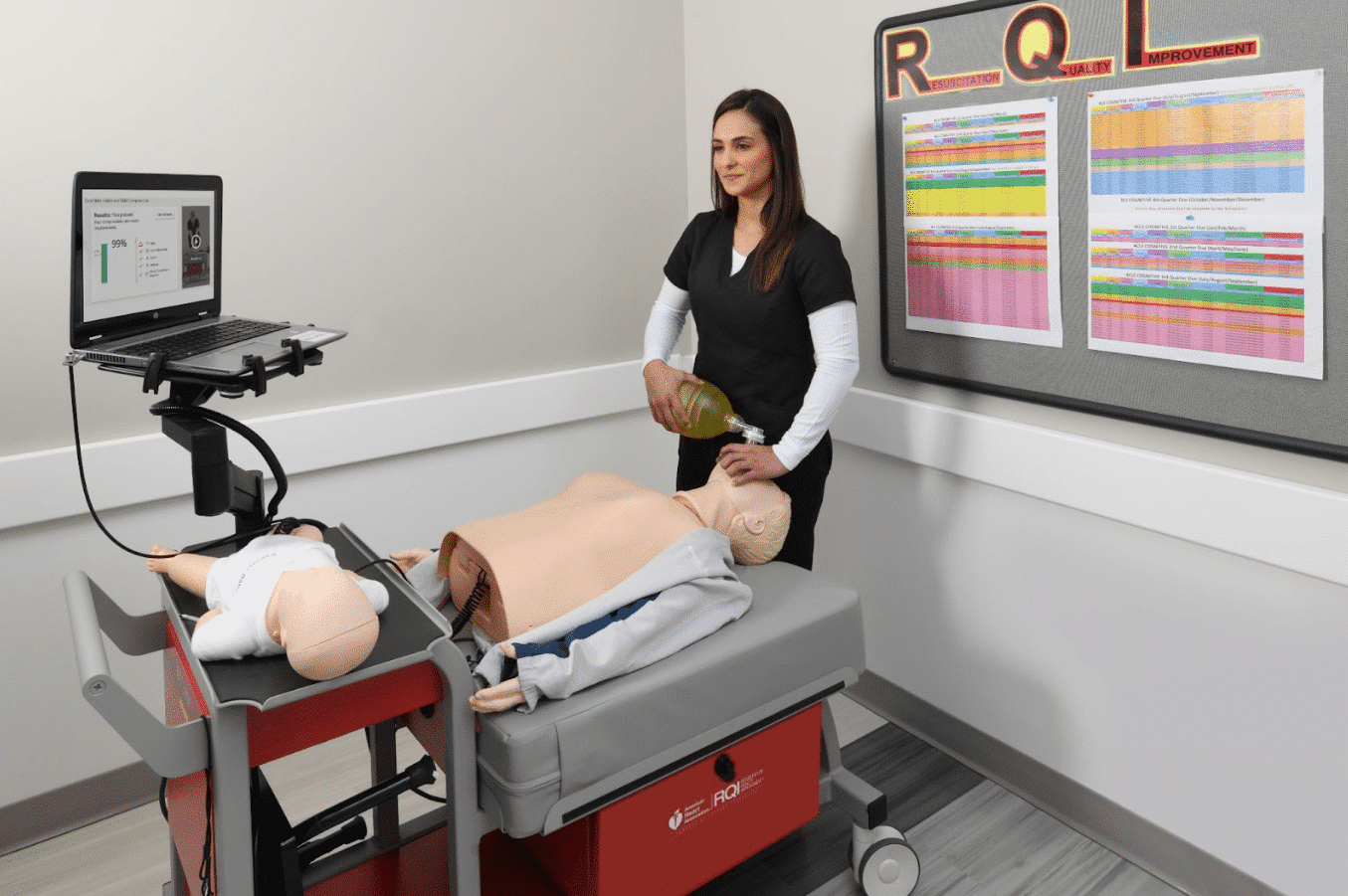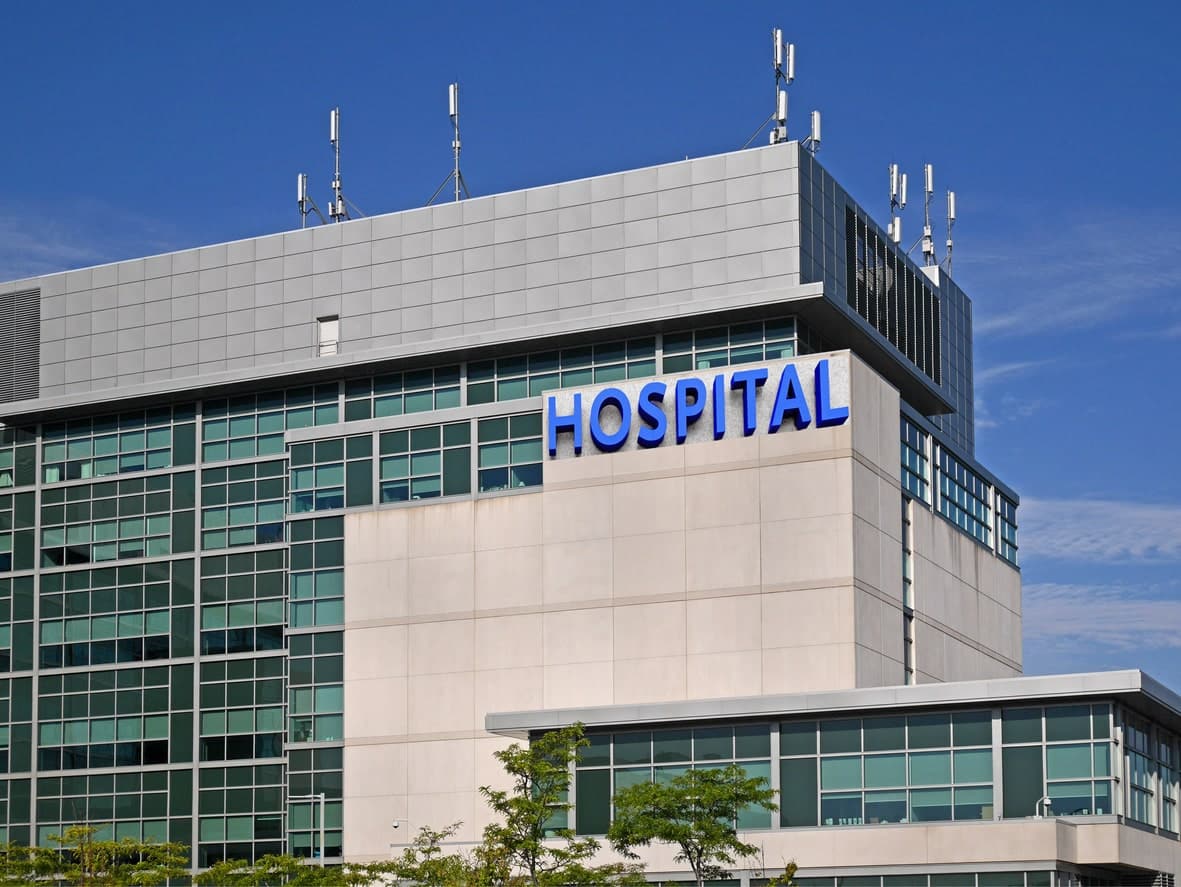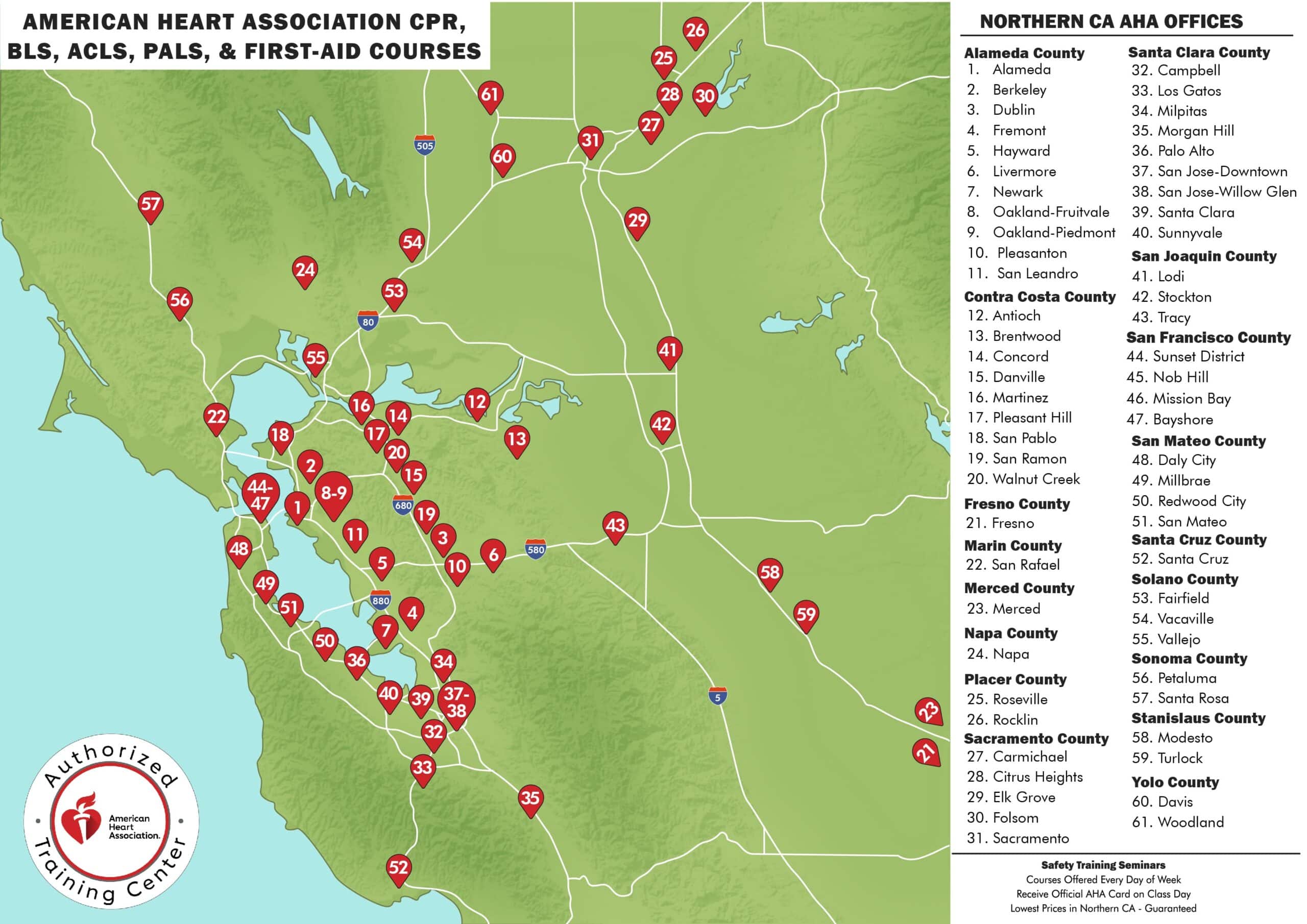
CPR Classes in Petaluma
BLS, ACLS, PALS, CPR & First-aid Classes
What is American Heart Association RQI
The American Heart Association RQI (Resuscitation Quality Improvement) program is one of the most popular, modern, and efficient ways for medical and healthcare professionals to receive their official American Heart Association BLS, ACLS, and PALS certification cards.
Three Easy Steps
1. Take the American Heart Association online course at home (a few hours).
2. Arrive to one of our 45 local offices and practice with the VAM (voice assisted manikin).
3. Receive your certification card on the day of the class.

About American Heart Association RQI
Entry Instructions for Petaluma CPR Classroom
Petaluma, California: Delivering Compassionate Healthcare in a Picturesque Setting
Introduction: Nestled in the heart of Sonoma County, Petaluma, California, is not only known for its charming scenery and historical landmarks but also for its exceptional medical facilities and commitment to providing quality healthcare services. With a blend of state-of-the-art hospitals, specialized clinics, and a focus on community well-being, Petaluma stands as a model of healthcare excellence in the region.
Diverse Medical Landscape: Petaluma offers a diverse range of medical facilities that cater to various healthcare needs and specialties. From comprehensive hospitals to specialized clinics, the city’s healthcare options ensure that residents have access to a wide spectrum of services. Whether it’s primary care, specialized treatments, or preventive care, Petaluma’s medical institutions prioritize patient well-being and optimal health outcomes.
Leading Medical Institutions: The city is home to several leading medical institutions that have gained recognition for their commitment to healthcare excellence. Petaluma Valley Hospital, a part of the St. Joseph Health network, delivers a wide range of medical services and serves as a cornerstone of medical care in the region. With its advanced medical technologies and skilled healthcare professionals, the hospital is dedicated to providing personalized care to each patient.
Community-Centered Care: Petaluma’s medical facilities embrace a community-centered approach to healthcare, reflecting the city’s warm and welcoming atmosphere. Local clinics and healthcare centers focus on building relationships with patients, understanding their unique needs, and fostering a sense of trust and comfort. This patient-centered approach ensures that residents receive compassionate and tailored care that addresses both their medical and emotional needs.
Wellness and Preventive Care: Petaluma places a strong emphasis on wellness and preventive care, aiming to empower residents to lead healthier lives. Community health events, workshops, and education programs are regularly organized to raise awareness about healthy lifestyles, disease prevention, and the importance of regular check-ups. By fostering a culture of wellness, Petaluma’s medical facilities contribute to the overall health of the community.
Advanced Medical Technology: Reflecting the ever-evolving landscape of healthcare, Petaluma’s medical institutions incorporate advanced medical technologies to enhance patient care. From cutting-edge diagnostic tools to state-of-the-art treatment modalities, these technologies enable healthcare professionals to provide accurate diagnoses and effective treatments. Telemedicine services have also gained prominence, offering patients the convenience of virtual consultations and medical advice.
Support for Mental Health: Recognizing the importance of holistic healthcare, Petaluma’s medical facilities offer support for mental health and emotional well-being. Mental health clinics, counselors, and therapists work collaboratively to provide patients with a safe space to address their mental health concerns. This integrated approach to healthcare ensures that both physical and mental health are given equal importance.
Emergency Medical Services: Petaluma’s emergency medical services (EMS) play a vital role in ensuring the safety and health of the community. Highly trained paramedics and emergency medical technicians (EMTs) respond swiftly to medical emergencies, providing critical care on the scene and during transportation to medical facilities. Their expertise and rapid response contribute significantly to saving lives and promoting community well-being.
Conclusion: Petaluma, California, is a city that not only captivates with its scenic beauty and historical charm but also shines as a center of healthcare excellence and compassion. With its leading medical institutions, community-centered care, and commitment to holistic well-being, Petaluma’s medical landscape stands as a testament to the power of quality healthcare in enhancing the lives of its residents. As the city continues to grow and evolve, its dedication to compassionate healthcare remains a cornerstone of its identity, ensuring that Petaluma remains a vibrant and healthy community for years to come.
Life-Saving Skills: Exploring CPR, BLS, ACLS, and PALS Classes
In the realm of emergency medical care, few skills are as crucial as Cardio-Pulmonary Resuscitation (CPR) and Advanced Cardiac Life Support (ACLS), Basic Life Support (BLS), and Pediatric Advanced Life Support (PALS) techniques. These life-saving techniques form the backbone of first response and medical intervention, often making the difference between life and death in critical situations. Let’s delve into the significance of each of these classes and their role in maintaining public health and safety.
Cardio-Pulmonary Resuscitation (CPR): CPR is a fundamental life-saving technique that can be administered by trained individuals to sustain blood circulation and provide artificial respiration when a person’s heart has stopped beating. CPR involves a combination of chest compressions and rescue breaths, aimed at keeping oxygenated blood flowing to vital organs until professional medical help arrives. CPR classes provide participants with the skills to recognize cardiac arrest, perform effective chest compressions, and deliver rescue breaths. These classes are vital for both medical professionals and laypersons, empowering them to respond swiftly and effectively in emergencies.
Basic Life Support (BLS): BLS takes CPR skills to the next level by incorporating additional techniques and equipment usage. BLS classes are designed for healthcare providers, including doctors, nurses, paramedics, and emergency medical technicians (EMTs). Participants learn how to assess a patient’s condition, deliver high-quality CPR, and use automated external defibrillators (AEDs) to restore a regular heartbeat. BLS training emphasizes teamwork, effective communication, and quick decision-making to optimize patient outcomes during cardiac emergencies.
Advanced Cardiac Life Support (ACLS): ACLS is an advanced course tailored for healthcare professionals who are involved in the management of cardiac arrest and other cardiovascular emergencies. ACLS builds upon the foundation of BLS and focuses on identifying and treating potentially life-threatening conditions such as stroke, myocardial infarction, and arrhythmias. Participants learn to interpret electrocardiograms (ECGs), administer medications, and perform advanced airway management. ACLS classes equip medical personnel with the skills to respond confidently to complex cardiac scenarios, ensuring comprehensive care for critically ill patients.
Pediatric Advanced Life Support (PALS): PALS training is geared towards healthcare providers who care for infants and children during emergencies. Pediatric patients have unique physiological needs, making PALS classes essential for those working in pediatrics, emergency medicine, and intensive care. PALS courses cover topics such as pediatric assessment, effective respiratory support, and the management of pediatric cardiac arrest. Participants gain the knowledge and skills necessary to provide specialized care and interventions that can make a critical difference in the outcomes of pediatric emergencies.
NRP, or Neonatal Resuscitation Program, is a critical medical initiative that focuses on saving newborns who struggle to breathe at birth. This specialized training equips healthcare providers with the skills to assess and manage respiratory distress in infants. NRP emphasizes a systematic approach, teaching effective ventilation techniques and chest compressions if needed. Regularly updated guidelines ensure that participants stay current with the best practices in neonatal care. By enhancing healthcare professionals’ abilities to respond swiftly and effectively to newborn respiratory challenges, NRP plays a vital role in improving infant survival rates and ensuring a healthier start to life.
First-aid classes offer indispensable life skills that empower individuals to respond confidently in emergencies. These structured courses cover a spectrum of situations, from minor injuries to critical incidents, teaching participants how to provide immediate care before professional help arrives. Participants learn to administer CPR, treat wounds, manage choking, and address common health crises. Hands-on training fosters essential skills and boosts confidence, enabling swift and effective action in times of need. First-aid classes are invaluable for workplaces, homes, and communities, creating a network of capable first responders. Mastering these skills not only saves lives but also fosters a safer and more prepared society.
Incorporating these life-saving techniques into healthcare systems, workplaces, and communities can significantly enhance the response to medical emergencies. Quick and effective interventions provided by individuals trained in CPR, BLS, ACLS, and PALS can stabilize patients and improve their chances of survival before professional medical assistance arrives. Moreover, these classes promote a culture of preparedness, empowering individuals to step forward and take action when faced with emergency situations.
In conclusion, American Heart Association CPR, BLS, ACLS, and PALS classes play an indispensable role in equipping individuals with the skills and knowledge needed to respond effectively to various medical emergencies. These courses bridge the gap between bystander assistance and professional medical care, ultimately contributing to improved patient outcomes and increased survival rates. By investing in these life-saving classes, individuals and healthcare professionals alike become vital links in the chain of survival, ensuring that timely and appropriate care is delivered when it matters most.
Our Blog

Hospitals & Medical Centers in Petaluma
Stay informed, stay prepared, and take proactive steps towards maintaining your health with the exceptional medical institutions in Petaluma, CA.

Psychological Recovery for CPR Survivors
The aftermath of cardiac arrest goes far beyond the lifesaving act of Cardiopulmonary Resuscitation (CPR). For the fortunate individuals who beat the odds and return

Why CPR is Important in Healthcare
Cardio-pulmonary resuscitation (CPR) is a life-saving technique that everyone should know how to perform. It involves a series of actions designed to help someone who

7 Common CPR Myths Debunked
Cardiopulmonary resuscitation (CPR) is a life-saving technique that can help a person in the event of cardiac arrest. It involves chest compressions that are performed

Importance of Workplace CPR & First-Aid Training
Accidents can happen anytime and anywhere, even in the workplace. Although we may try our best to ensure a safe and healthy work environment, we


